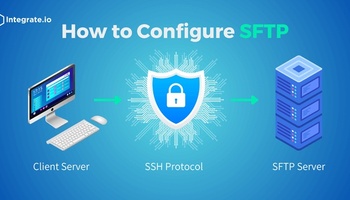Cybercriminals are currently enjoying a golden age. The sudden shift to remote working, combined with the digitization of everyday life, means endless opportunities to compromise systems and access sensitive data. If you don't want your organization to be their next victim, you must have to know how to prevent data breaches.
The Cost of a Data Breach
The damage a data breach does to a business cannot be understated. A recent study by IBM shows that:
- Companies lose an average of $150 per record in a data breach
- Data breaches involve an average of over 25,000 records
- The average cost of recovering from a data breach is over $8 million for American companies
- It takes 279 days for most companies to identify and rectify breaches
Those are just the tangible figures. You also have to think about how losing customer information can cause reputational damage and how shoddy information security and constant data leaks might create a competitive disadvantage.
Protecting sensitive data is more challenging than ever, especially when so many people are working remotely. But before we talk about how to prevent data breaches, let's first examine how breaches occur.
How Do Data Breaches Happen?
Most data breaches are a mix of high-tech infiltration techniques, manipulation, and luck. Common techniques include:
- Malware: Users can unintentionally install a virus by visiting an infected website or opening an infected email attachment. Malware comes in many forms, such as spyware that silently harvest sensitive data in the background, keystroke loggers that capture passwords, and ransomware that encrypts your entire systems.
- Phishing: Phishing emails look like a genuine request to log in to an online service, such as your bank account. But the link in the email directs users to a counterfeit phishing website, where they enter their login credentials. Once the hackers have the username and password, they can simply log into the real site.
- Insider attack: Rogue employees and contractors can steal data and sell it to hackers. Cybercriminals can also simply walk into an office and access a terminal if that office lacks adequate physical security measures. Never underestimate the damage that simple human error can cause.
- Man-in-the-middle: Hackers have scams that allow them to intercept data as it moves between points. For example, a criminal might sit in a café and create a public wi-fi hotspot with a name like COFFEE_SHOP_PUBLIC_WIFI. If anyone connects to this network, the hacker can capture their data.
- Lost or stolen device: Employees often carry laptops and USB drives with sensitive data, especially when working remotely. These devices can fall into the wrong hands, either through loss or theft.
- Social engineering: Hackers can use manipulation techniques to trick people into granting systems access. This technique is even easier in the age of social media. Look at anyone's feed, and you can find dozens of password clues, such as birthdays, favorite sports teams, and the names of children or pets.
How Do You Prevent Data Breaches?
If you want to understand data breach prevention, you first have to think like a hacker. That means looking at the whole of your infrastructure, including your users, and trying to identify weak points in your data security strategy. Here are seven essential steps to help protect your sensitive data.
1) Train Your Employees to Recognize Phishing Emails
An international study by Interpol shows that phishing attacks increased by 59% during the early months of the Covid-19 pandemic. These attacks are becoming more sophisticated, and even tech-savvy users can fall for a well-crafted phishing email.
If your employees don't know how to recognize common signs of phishing attacks, then any cybercriminal could gain access to your data. After all, it only takes one person to compromise an entire system.
Even criminal defense lawyers, like the team at Spolin Law P.C., see that when companies utilize cybersecurity best practices they have the tools they need to investigate what really happened, especially in the case of identity theft.
The right security training can help employees spot phishing attempts and dangerous links. Make sure your workers know to look for signs like:
- Poor grammar or misspellings
- Anonymous messages that don't identify the employee by name
- Emails that come from free domains like Gmail.com or Yahoo.com
- Emails that include web links instead of text-based messages
- Unsolicited attachments that could carry malware
- Domain names that don't match the company's name (Fedx.com instead of Fedex.com, for example)
You can also use phishing simulators like Infosec IQ, Gophish, or LUCY to test your employees' ability to spot fraudulent emails. When you find knowledge gaps, you can include new information in your next training session.
Keep your employees updated about the most recent phishing trends, and encourage them to report suspicious emails to their managers.
2) Use Security Levels to Limit Access to Sensitive Data
Only a few of your employees need access to sensitive data such as client payment info and business development plans. A customer service worker, for example, doesn't need to view a client's credit card number. Perform a data audit and make sure that all sensitive data is on a need-to-know basis.
Set a security level for each person so you can limit their access to systems. Doing so will make it harder for a hacker to steal data while using an employee's profile. Most operating systems and major software apps make it easy to set security levels. Microsoft, for instance, uses sensitivity labels that encrypt files and folders. Only users with permission can view the folder's contents.
It's also a good idea to monitor event logs to see who's accessing sensitive files and folders. Many cloud platforms will offer detailed analytics reports so you can identify any unauthorized access and change permissions accordingly.
3) Update On-Prem Software or Migrate to Cloud
Cybercriminals and software developers play a constant game of cat-and-mouse. When developers release new products, hackers start looking for vulnerabilities they can use to infiltrate user systems. In response, developers have to write new code that blocks the vulnerabilities that hackers find.
Most operating systems and enterprise applications have an automatic update option. However, it's up to you to enable this. A lot of IT teams choose not to perform automatic updates so that they can maintain a stable environment. This is an acceptable approach, but you need to factor it into your risk mitigation strategy and create alternative processes.
Another alternative is to migrate to the cloud. Cloud providers update their systems updates automatically, which means that you're always logging into the latest version. You also have the protection of the cloud service's data security measures, which tend to be more robust than enterprise-level cybersecurity.
4) Take Steps to Protect from Malware
If you're storing sensitive data, you must have enterprise-grade virus protection on all systems. This offers a layer of data protection against viruses, keystroke loggers, and other malicious programs that could lead to a data breach.
However, anti-virus is just one tool in the fight against malware. Education is perhaps the best way to keep malicious programs out of your network. Support your users and help them to recognize the risks of opening email attachments or visiting unfamiliar websites. When in doubt, don't click it.
You can also limit the impact of malware by taking proactive measures. Ransomware, for example, locks away your data until you pay a ransom. You can mitigate this risk by keeping business-critical data in a secure environment, such as a data warehouse.
5) Use VPNs to Protect Remote Workers
Remote working is generally secure, as many cloud services use a robust level of encryption. However, remote workers are sometimes vulnerable to man-in-the-middle attacks, especially when using public wi-fi. This kind of attack can expose login credentials, financial information, and other personal data.
A Virtual Private Network (VPN) is one method of preventing data interception, even if the user falls for a man-in-the-middle attack. VPNs offer end-to-end encryption, so it encrypts data on the sender's side and decrypts it on the recipient's side. If anyone intercepts packets in transit, they won't be able to extract any meaningful data.
You can establish a VPN on your on-premise servers and grant access to users. Alternatively, there are cloud-based enterprise VPN providers such as Perimeter 81, NordVPN or Tor Guard.
6) Find Vulnerabilities in Your Cybersecurity Network with Penetration Testing
Penetration testing, also called pen testing, helps you find any existing weaknesses in your system. Penetration testing tools will scan your system and list each vulnerability by category and severity.
You can perform a pen test at any time to probe your system for weaknesses. Some of the most important times for a pen test, however, include when you:
- Connect a new office to your network
- Upgrade or add applications to your system
- Add new infrastructure to your network
- Change your security policies
You can hire a security team to test your system, or if you don't have room in your budget to hire security contractors, you can use open-source tools like:
- Metasploit Project, a comprehensive penetration testing framework that looks for the oldest and newest vulnerabilities
- Wireshark, which analyzes your network protocols and gives you a security report
- John the Ripper, which will try to crack your (hopefully) strong passwords
For the best results, use a combination of pen testing tools to probe your system.
What Should You Do After a Data Breach?
If you follow the steps above and perform a thorough audit of your data security measures, you should now understand how to prevent data breaches.
Unfortunately, data breaches can happen to even the most prepared companies. In 2020 alone, we saw massive cyberattacks at Nintendo, Twitter, and Zoom. If you discover that hackers have compromised sensitive data, you need to have a response plan in place to protect your end-user information.
1) Let Clients Know That the Data Breach May Affect Them
Most states in the U.S. have laws requiring you to inform clients of data breaches that may affect them.
More importantly, clients deserve to know that a criminal may have their personal data. Clients may need to notify their banks, check their credit reports, order new credit cards, or take other actions.
Keeping people informed will also help limit the PR nightmare your company faces. A data breach is bad for your reputation. An attempted cover-up is worse. When you keep customers informed, you can let them know the extent of the breach. This helps them decide how they can protect themselves, and what steps you're taking to fix the problem.
2) Determine How the Data Breach Happened
You need to know how a data breach happened so you can prevent future attacks. Your penetration testing tools should show you how the cybercriminal infiltrated your network.
If pen testing doesn't reveal the exploit, you need to hire a forensic network security expert. The hacker may have used a new exploit that your tools can't identify. A security professional, however, should know how to track the hacker's steps to discover the entry point.
3) Take Action to Limit Further Data Loss
Once you know how someone stole data from your system, you must take action to limit further loss. If you don't plug the hole, then the criminal will keep stealing from you.
With some luck, your penetration testing or security expert can show you how to patch the weakness in your system. If that isn't possible, take your network offline until you can find and fix the vulnerability.
4) Implement New Data Security Standards to Prevent Future Security Breaches
Data breaches are an opportunity to re-evaluate your security standards. After reviewing the situation, you may decide that it's time to:
- Update your employee security training to include new trends
- Purchase new network hardware that meets the latest security standards
- Start encrypting more of your data instead of assuming that criminals won't target you
- Get security software that knows how to scan your network for the most recent types of attacks
- Reconsider which employees and managers need access to sensitive files
- Replace unsecured apps with better options
- Get security certifications like SOC 2 and comply with their guidelines
Before you start a new data integration project, invest in an application that will make the job easy and secure.
Integrate.io and ETL Security
Sensitive information leaks can harm your brand and create misery for your customers. Companies of all sizes need to keep up with the latest security trends so they know how to prevent data breaches. Tools and training will help you reduce the risk of attack. It's also good to know some of the common security threats you're facing.
With Integrate.io, you can trust that we follow the necessary data compliance laws (HIPAA, GDPR, CCPA) and strive for data security. Integrate.io is a cloud-based ETL solution that makes it easy to create and visualize data pipelines from a variety of sources and destinations. We use the latest security protocols and tools like 2FA to keep unauthorized users away from your information.
Schedule an introductory call to learn more about the data integration and security benefits that you get from using Integrate.io as your ETL platform.










